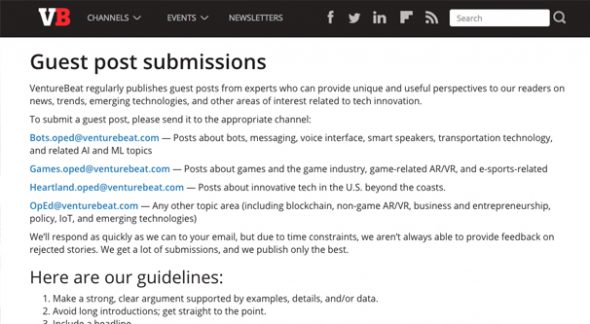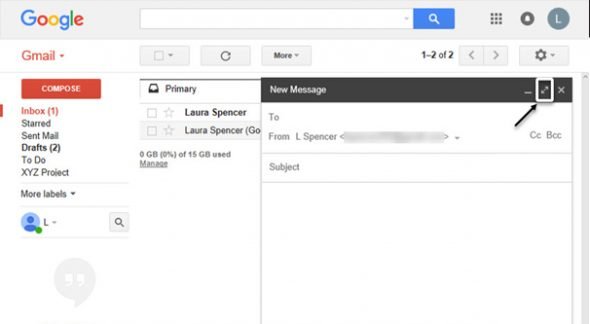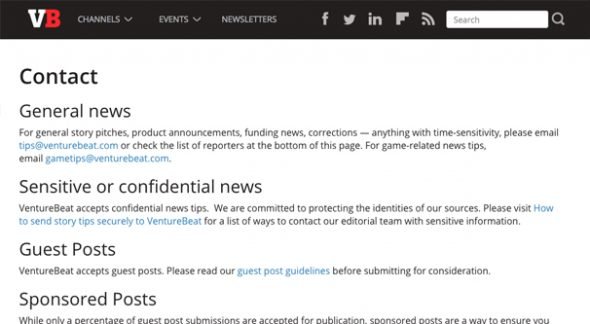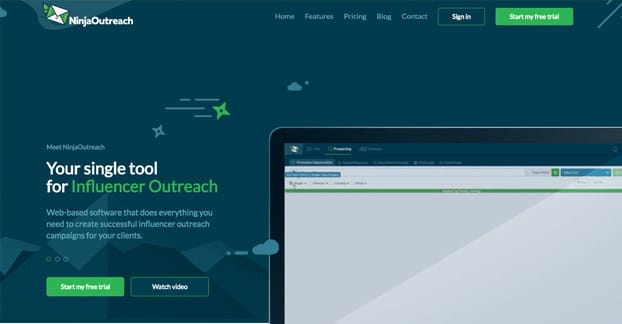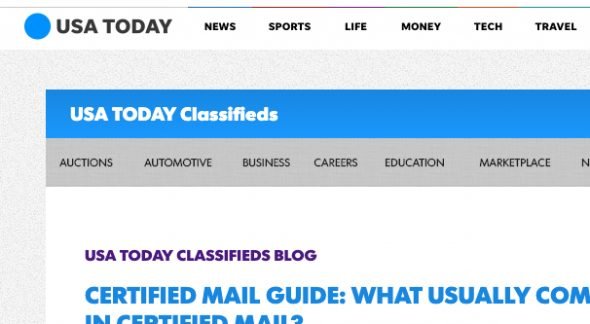VentureBeat is one of the top general interest blogs in the world today, focused on tech savvy content and with readers interested in all areas of technology, pop culture, news, and more. They’ve been around for a little over a decade, making them pretty new amongst major web properties, compared to the hundred-year history of publications like Forbes anyway. They have, according to their partnership and advertising page, over 8 million monthly unique readers. One heck of an audience to reach, if you can reach it.
Step 1: Learn VentureBeat
The first thing you need to do before you even begin to think about pitching an article to any publication is do some legwork. Put your boots to the ground, metaphorically speaking, and get yourself familiar with the publication you’re attempting to reach.
In the case of VentureBeat, there’s a lot to consider. Obviously, you’re not going to be able to read everything published on the site in a given month, or what have you; they publish so much content, something new is going up every few minutes. Instead, you should do a broad overview, then drill down in your area of expertise.
First up is the broad overview. VentureBeat is a large publication with numerous channels covering individual topics. These channels are Artificial Intelligence, Augmented/Virtual Reality, Big Data, Business, Cloud, Commerce, Development, Enterprise, Entrepreneur, Esports, Heartland Tech, Marketing, Media, Mobile, PC Gaming, Security, Social, Transportation, and GamesBeat. The last one, GamesBeat, is a specific channel dedicated to talk about the gaming industry, and includes content that can fall into other categories, including virtual reality, mobile gaming, PC gaming, and industry news.
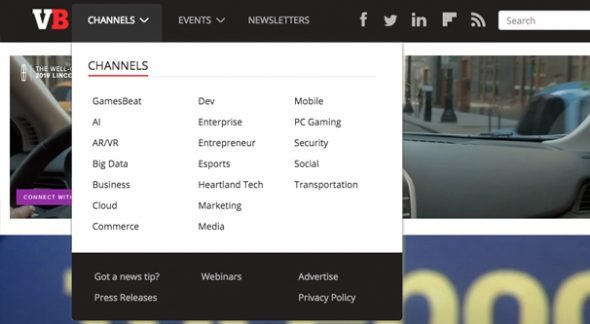
Heartland Tech, by the way, is a unique channel that specifically focuses on technology and innovation that takes place in the united states, but is not centered around one of the coastal cities that are so often covered by other publications. This isn’t for your silicon valley startup, it’s for an innovative tech solution coming out of Oklahoma or Kansas. You know, the American Heartland.
VentureBeat also publishes press releases, sponsored by BusinessWire. You won’t be able to submit a press release directly to them. Instead, you will need to visit BusinessWire themselves and submit press releases to them. They’re a high quality company, owned by Berkshire Hathaway, but you should remember that it will cost money and it’s not guaranteed to get you on VentureBeat.
Still, this isn’t a post about press release marketing, it’s about guest posting. I’ll go ahead and ignore press releases for now. Likewise, you can pay VentureBeat directly through their advertising channel to get a sponsored post. This is also expensive and also bypasses everything involved with guest posting, so it’s not really applicable to this situation either. If you’re interested in just paying for exposure with a sponsored post, contact [email protected].
Step 2: Research Your Channel
Take a step back and think about your business. What do you do, and how does it relate to one of the content channels on VentureBeat? You can cover a lot of different topics in their broad categories. Media, Business, Entrepreneur, and Marketing alone can cover basically everything published on other sites entirely, like Entrepreneur.com or Forbes. Essentially, anything that has a tech involvement, has national or global exposure, and is newsworthy can be published on VentureBeat.
Figure out which channel, or which several channels, are most likely to be the ones you want to reach. VentureBeat doesn’t hugely segment their content, but they do have readers who peruse only specific channels, so you’ll be reaching a section of their audience rather than the whole thing. Make sure the audience you want to reach is reading the channel you’re investigating.
Remember that just because your company is focused on one thing doesn’t mean you can’t be published in another. For example, a mobile game developer can write content about game dev and show up in GamesBeat, in Mobile, in AR, or even in AI if there’s something innovative about the game. On the other hand, you can leverage your experience in building a gaming company to write something relevant to the Business or Entrepreneur channels.
Also remember that content in one channel may be cross-visible in other channels. You can browse around from one to another and see content that is relevant to multiple channels visible in the feeds for all of them. VentureBeat works essentially through a tagging system, so there’s a lot of cross-over.
Nevertheless, you want to identify a specific area of expertise where you have a better than normal chance of being published, and focus your reading on that channel. This will give you a good idea of what sort of content, perspectives, and topics are covered in that channel. You don’t want to pitch something to a channel that doesn’t really fit.
It’s worth noting here that if you want to do something like cover industry news, you need something truly unique to fit in. VentureBeat has a lot of regular contributors that cover daily news in all of their major industries. To write something about normal industry news is to step on the toes of an existing writer, and likely be rejected. The fact is, by the time you’ve drafted and submitted a pitch, they’ve drafted and submitted an article. By the time the editor reads your pitch, the article will be published, and you’ll simply be duplicating what is already covered.
For this reason, opinion pieces and pieces with hard data, case studies, and pieces that take advantage of your unique perspective are a better idea. For example, back when Pokemon Go was in full swing, I wrote this piece about how local businesses were taking advantage of the app’s geographic tagging and capturing foot traffic from players. Many people covered the phenomenon of Pokemon Go, and sure, a lot of people mentioned how businesses were starting to use it, but I was able to get this perspective in before others covered it.
Step 3: Learn the Guest Post Requirements
VentureBeat is nicely up front with their guest post guidelines and requirements.
Here’s a summary of what they say, but in case they update them, you can find them here.
- Make a strong, clear argument that is supported by data, examples, citations, studies, or other evidence.
- Avoid lengthy introductions. VentureBeat likes shorter, snappier content with immediate impact.
- Include your headline in your pitch.
- Include an author bio in your pitch, which should include details of why you’re the right person to write this content.
- If you’re not the author, disclose your organization and relationship with the author.
- Only unique content, no syndication or prior published content. They claim to accept previously published content on rare occasions, but there’s no reason for you to try it and hurt your chances.
- Full disclosure. If you have sponsorship, partnerships, or other relationships with anything you’re covering or talking about, it needs to be disclosed.
- Nothing promotional. If you mention your own brand or company in any way, it needs to be in context and non-sales. “As CEO of X, I can tell you how this affects the industry” is valid. “Now that I’ve discussed a problem, my company Y can solve it for you” is not.
- You do not necessarily need to include images, but they like it if you do. If you include images, make sure you have the rights to them, and that you include credits and links to the sources if applicable.
- Submit pitches of 1-3 paragraphs in summary of your post, or submit a full draft. Drafts are probably better.
- Submit your drafts in Google Docs format. They prefer anything that’s easy to edit, so no PDFs.
- Do not submit to more than one email address at once. More on that in step 5.
- Aim for a target word count of 600-1,200 words. In my experience, closer to 1,200 tends to be better.
Step 4: Come Up With a Pitch
For your first post on VentureBeat, you probably want to come up with something that has at least a little evergreen potential. More importantly, you want something that’s not going to be obsolete by the time it passes through the editor’s email box. I generally like to come up with something that covers a second-tier or third-tier topic, rather than a first-tier.
What does that mean?
- First-tier: News. A first-tier topic is something like “Business A acquires Service B” or “Business C announces bankruptcy.” These topics are likely already taken by existing writers, or have too much of a delay between your pitch and publication to be relevant to a news-seeking audience.
- Second-tier: Commentary on the news. If business A buys service B, what does that mean for their competitor or the industry at large? This is an ideal position to be in, if and only if you have direct experience or first-hand relevance to the situation. If you’re the competitor, or have details about the contract or buyout, you can use your unique position to bring value to the article you write.
- Third-tier: Commentary on the commentary. You’ve all seen marketing posts about how, for example, guest blogging is dead as tier one, why guest blogging is dead as tier two, and why those people are wrong as tier three.
The third tier of commentary is very similar to the second tier, but it tends to come later, after some implications have shaken out, or after there are second-tier commentary posts to respond to. If one person argues one perspective, and you have good reason and data to argue the opposite, you can write a third-tier post arguing against what they published.
The problem with third-tier writing is that you might run afoul of institutional perspectives. For example, a lot of sites covering political news are biased in one direction or the other. They’ll cover first-tier news and second-tier commentary biased to their perspective, but they won’t want to publish a well-reasoned argument in the third-tier that goes against their perspective.
Coming up with a pitch that sits in the tier-two or tier-three range, commenting on recent trends or the reaction to those trends, is crucial. It’s the kind of leg-up thinking that editors love to see, while also avoiding stepping on the toes of established writers. Just make sure you aren’t taking a position arguing that some specific writer is an idiot, not realizing that the writer you target is actually the editor you’ll be contacting.
Step 5: Submit Your Pitch
When you have a pitch, it’s time to figure out how to submit it to VentureBeat. Luckily, VentureBeat is more open to submissions and more open with their processes than a lot of other publications.
First up, avoid the tip submission pages. If you submit something to tips@venturebeat or gametips@venturebeat, you’re basically just giving away your pitch. Tips are for assigning to their journalists, not for getting yourself a position writing.
You should also familiarize yourself with the editors for the relevant channels. Again, unlike some other publications – cough Forbes cough – VentureBeat is up-front with who manages what channel. Their contact page lists the editors for each individual editor and staff member.
Now, you won’t be submitting pitches directly to the editors, at least not right away. The first submission you deliver to VentureBeat should go through the appropriate channels. There are four ways to contact them.
- [email protected]. Send pitches to this address for posts about bots, messaging, voice interfaces, smart speakers, transportation technology, artificial intelligence, and machine learning topics.
- [email protected]. Send pitches to this address for posts about games, the gaming industry, game-related augmented or virtual reality, and e-sports.
- [email protected]. Send pitches to this address for posts about tech and tech innovations specifically taking place in the USA but away from the coasts. See the channels section up above.
- [email protected]. Anything else, including blockchain, non-gaming augmented reality or VR, business, entrepreneurship, emerging tech, and other such content goes to this email address. It’s the catch-all for anything that doesn’t fit in one of the other specific sections.
You can submit a pitch, or you can submit a full first draft. I recommend submitting a full draft. If they like it, they’ll publish it or make a few edits and then publish it. If they don’t like it, well, you can use it elsewhere.
There’s not much you can do beyond wait, once you submit your draft. They’ll either respond or they won’t. Don’t try to follow up with the submission email, it will be discarded. If you like, you can try to contact the editor of the channel most likely to be reviewing your content, but stepping outside of the process isn’t necessarily good either. Play it by ear and, if you’re ignored, try again with a new pitch idea.
 ContentPowered.com
ContentPowered.com


